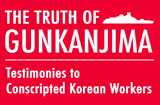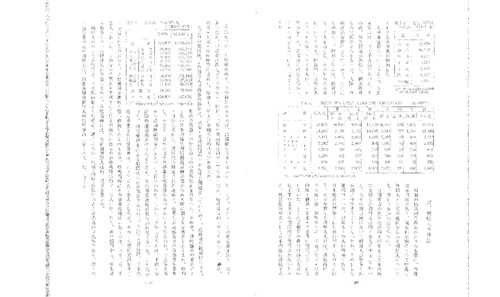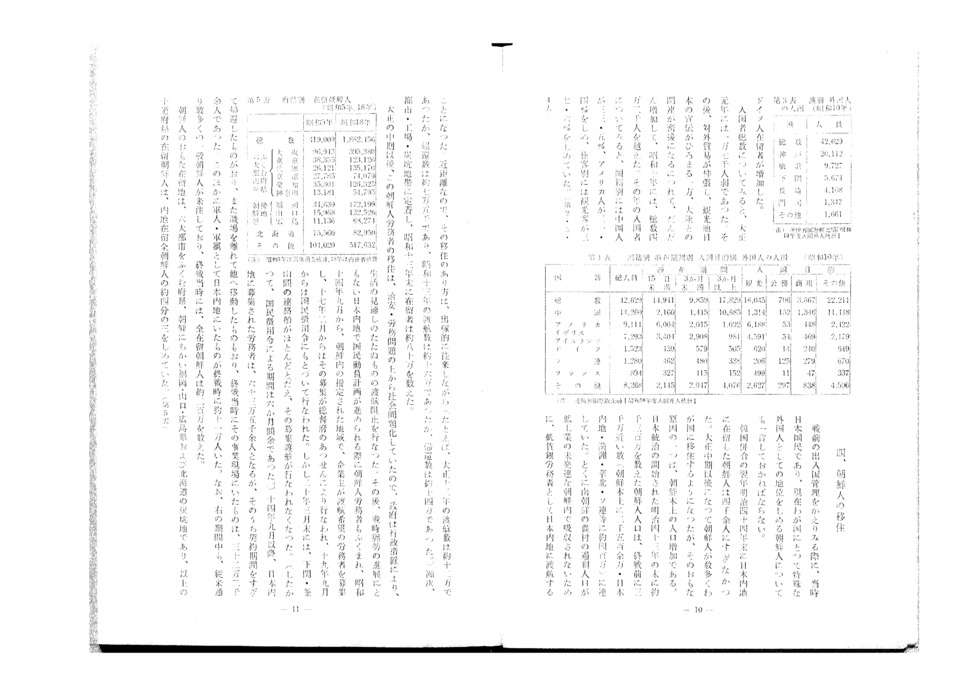Immigration Control Report: Immigration Control and its Current Situation 1959
- Author
Page 1
- Migration of Korean Nationals
When looking back at pre-war immigration control, it is necessary to say a few words about Koreans, who were Japanese citizens at that time and presently hold the status of special foreigners in Japan.
At the end of 1911, which was the year after the Japanese annexation of Korea, there were just over 4,000 Koreans residing in Japan. Many Koreans began migrating to Japan from the middle of the Taisho period (1912-1926), and one of the main reasons for this was the population increase on the Korean peninsula.
The population of Korea, which was approximately 13 million at the end of 1910 when Japanese rule began, had reached nearly 30 million before the war ended (more than 25 million on the Korean peninsula and approximately 4 million in Japan, Manchuria, northern China, the U.S.S.R., etc.). In particular, because the surplus population in agricultural villages in southern Korea were not absorbed in Korea where the mining and manufacturing industries were undeveloped, Koreans came to cross over to Japan for employment as low-wage laborers. Because of the close proximity, the migrants would come and go (for example, in 1924, around 120,000 Korean migrants came to Japan but about 75,000 returned to Korea, and in 1938 around 160,000 came to Japan but about 140,000 returned to Korea). They gradually settled in urban, industrial, and mining regions, and the number of Korean residents in Japan was roughly 800,000 at the end of 1938.
From the middle of the Taisho period, this migration of Korean laborers was seen as a social problem in terms of public order and labor, and the government took administrative measures to prevent migration of Koreans without prospects of making a living. Subsequently, when a National Mobilization Plan was advanced in Japan as the wartime conditions evolved, Korean laborers were included. From September 1939, in designated areas within Korea, Japanese business owners recruited laborers seeking to work in Japan, and from February 1942 this was mediated by the office of the Governor-General. Then from September 1944, this recruitment was conducted pursuant to the National Requisition Ordinance. By the end of March 1945, however, ferries between Shimonoseki and Busan had almost all stopped running, and the recruitment stopped. (As a result, the period under the National Requisition Ordinance was a little more than six months). The number of Korean laborers recruited within Japan after September 1939 totaled more than 635,000, but these included laborers who returned to Korea once their contract periods ended and others who left their workplaces and migrated to other locations. At the end of the war, there were some 322,000 recruited Korean laborers at various workplaces in Japan. In addition to these laborers, when the war ended, there were around 110,000 Koreans in Japan as soldiers or army civilian personnel. Beyond that, there were also a large number of Korean civilians who came to live in Japan during this period, as in the past. In total, there were roughly two million Koreans living in Japan at the end of the war.
These Koreans mostly lived in the prefectures where Japan’s six largest cities [Tokyo, Yokohama, Nagoya, Kyoto, Osaka, and Kobe] were located, in Fukuoka, Yamaguchi, and Hiroshima prefectures, which are close to Korea, and in the coal mine regions of Hokkaido. The Koreans residing in these 10 prefectures accounted for around three-quarters of all the Koreans living in Japan.
Table 3 Entry of Foreigners by Port (1935)
|
Port |
No. of Persons |
|
Total Kobe Yokohama Shimonoseki Nagasaki Moji Others |
42,629 20,112 9,727 5,674 4,108 1,347 1,661 |
Note: Ministry of Transport International Tourism Bureau, “FY 1935 Foreigner Entry Statistics.”
Table 4 Entry of Foreigners by Nationality, by Period of Stay, and by Purpose of Entry (1935)
|
Nationality
|
Total persons
|
Period of stay |
Purpose of entry |
|
||||
|
Less than 15 days |
Less than 3 months |
3 months or more |
Tourism
|
Official business |
Commerce |
Others |
||
|
All China US UK Ireland Germany USSR France Others |
42,629 14,260 9,111 7,293
1,523 1,280 894 8,268 |
14,941 2,160 6,004 3,404
439 462 327 2,145 |
9,859 1,415 2,015 2,908
579 480 415 2,047 |
17,829 10,685 1,092 981
505 338 152 4,076 |
16,045 1,314 6,188 4,591
620 206 499 2,627 |
706 152 53 54
14 125 11 297 |
3,667 1,346 448 469
240 279 47 838 |
22,211 11,448 2,422 2,179
649 670 337 4,506 |
Note: Ministry of Transport International Tourism Bureau, “FY 1935 Foreigner Entry Statistics.”



